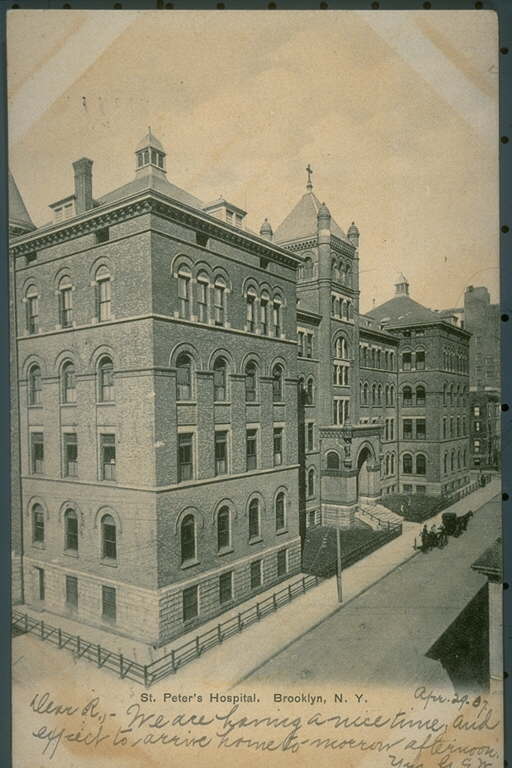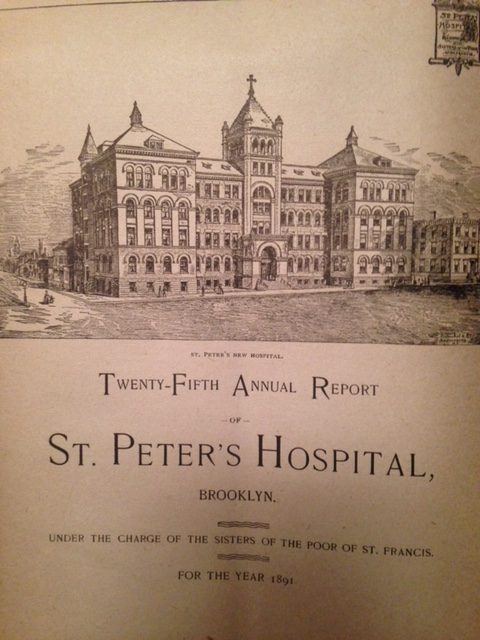
St. Peter's Hospital
By Susan K. Harris
It’s big, it’s red, it’s in our midst, and yet few of us have crossed the threshold. I’m talking about the Cobble Hill Health Center, located at 380 Henry St., between Congress and Warren. If Henry St is your North/South route, you pass it every day, noting the ambulances, the nurses and doctors coming and going, and the patients in their wheelchairs, watching you as you go about your day. You may also note the architecture (Romanesque Revival), and the plantings, which are lovely. If you are like me, you stop to admire the garden, and remind yourself to say hello to the residents sitting outside.
The Health Center building has been here for more than a century. During its first 75 years it housed St. Peter’s Hospital, which was founded in 1864 by the Reverend Joseph Franziola, rector of St. Paul’s R.C. Church on Warren and Hicks St. The original hospital building stood at the corner of Congress and Hicks, but the operation soon outgrew its quarters. Established to serve what was then a working-class neighborhood, St. Peter’s drew the majority of its patients from the docks, tenements, and factories of the surrounding area. The Sisters of St. Francis, also known as the Sisters of the Poor, ran the hospital from 1866 on. No one who could not afford it was charged; the Sisters raised the funds to keep the institution going from city agencies, local charities and philanthropists, and door-to-door soliciting. J.E. Clark, M.D., President of the hospital medical board, noted in 1884 that “The sisters have incurred a large debt to enable them the better to perform their work of charity and to extend its usefulness, and while they feel deeply grateful for the aid already received, there is still great need for continued assistance.” Despite their restricted budget, the sisters managed to raise the money for the new edifice, which was completed in 1888 and, according to the 1891 Annual Report, went into full operation in 1890.
Designed by J. William Schickel, the building was imagined on a large scale, with a main building, two wings, and outbuildings housing a chapel, the laundry, stables, the morgue and the furnace. Its patients came from Europe, the U.S., Canada, and other countries. The 1889 Report lists Ireland as the most frequent country of origin, followed by the U.S., Germany, and England. Four West Indians were treated, and two Turks. Most patients came from the working and lower middle classes: tinsmiths, messengers, and rope-makers were typical male occupations, but the hospital also treated middle-class individuals like clergymen, druggists, and policemen. Typical female patients worked in factories, operated telegraphs, taught school, and served as nurses, typists, governesses. The patients suffered from tuberculosis, from rheumatism, from bronchitis, from abcesses. The new building accommodated 300 beds, of which 250 were reserved for charity patients. During the 1884 year the hospital treated over 3,500 patients, free. For its first few years it also served as an orphanage, specifically for the children of soldiers, and as a military hospital.
St. Peter’s Hospital closed in 1962, just short of its 100th birthday. The building was taken over by a private operator two years later, reopening as the Congress Nursing Home. Reports from that time focus on the renovation that, according to most, destroyed the building’s original aesthetic, filling in windows, eliminating floors, peaked roofs, and the gracious entrance, and filling in gaps with inappropriate modern brickwork. The new owner was Eugene Hollander, a nursing home mogul with a checkered reputation; in 1976 he was forced to divest himself of the Congress St. Nursing Home after pleading guilty to Medicaid fraud.

After the Hollander debacle the community insisted on participating in plans for the nursing home’s future. A deal between the then-owners of the building, Community Board 6, and the Landmarks Preservation Commission enabled a partial restoration of the hospital’s original façade, including the front entrance and tower. Now listed as a Voluntary Not for Profit entity operated by the Cobble Hill Health Center, Inc., the institution is renamed the Cobble Hill Health Center. In 2012 Tony Lewis took over administration from Olga Lipschitz, who had overseen the nursing home since the 70s. Lipschitz, a Holocaust survivor who had compared the state of Brooklyn nursing homes in the 1970s to concentration camps, had profoundly changed the Cobble Hill Nursing Home’s nature, and the institution Lewis inherited was very different from the institution Eugene Hollander oversaw. The current health center focuses on short-term rehabilitation and home care services, adopts new technologies to senior care (such as using iPods with Alzheimer’s patients), and seeks links with the surrounding community. Landmarked since 1969, it is very much a part of Cobble Hill’s history–and present.
Selected Sources:
Annual Report of St. Peter’s Hospital, Corner of Congress and Hicks Streets, Brooklyn. Years: 1877, 1878, 1884, 1889, 1891. Brooklyn Historical Society, Box 8/11: Annual Reports of St. Peter’s Hospital, Brooklyn. Under the Charge of the Sisters of the Poor of St. Francis.
Asbury, Edith Evans. “Hollander Admits Fraud on Medicaid in Nursing Homes.” The New York Times, February 3, 1976. http://www.nytimes.com/1976/02/03/archives/new-jersey-pages-hollander-admits-fraud-on-medicaid-in-nursing.html?_r=0.
Gray, Christopher. “Streetscapes: St. Peter’s Hospital; Undoing a Disastrous Alteration.” The New York Times, Real Estate Section, April 18, 1993. http://www.nytimes.com/1993/04/18/realestate/streetscapes-st-peter-s-hospital-undoing-a-disastrous-alteration.html.
Miller, Carly. “Care & Chutzpah: How a Holocaust Survivor Cleaned Up Brooklyn.” Brownstoner, February 14, 2017. https://bklyner.com/care-chutzpah-holocaust-survivor-cleaned-brooklyn-nursing-homes/.
Prisco, Joanna. “New President for Cobble Hill Health Center.” May 7, 2012. https://patch.com/new-york/carrollgardens/new-prez-for-cobble-hill-health-center.
Spellen, Suzanne. “Building of the Day: 380 Henry St.” Brownstoner, March 27, 2012. https://www.brownstoner.com/architecture/building-of-the-day-380-henry-street/.